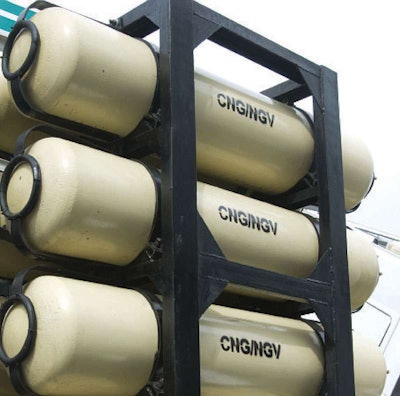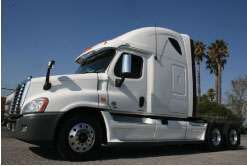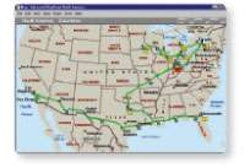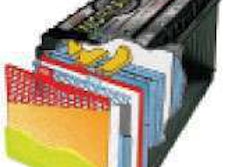Product reviews, OEM & supplier news and equipment management trends
The future of fleet energy
Price spikes slowly driving U.S. toward alternative fuels
 Both compressed natural gas and propane yield roughly a 12 percent drop in general vehicle efficiency compared to higher-priced diesel and gasoline, but today’s fleet managers are realizing they can work with that number.
Both compressed natural gas and propane yield roughly a 12 percent drop in general vehicle efficiency compared to higher-priced diesel and gasoline, but today’s fleet managers are realizing they can work with that number.Sitting in the front row listening to U.S. Energy Secretary Dr. Stephen Chu speak at the NTEA Work Truck Show in Indianapolis was about as close as I’ll ever get to the Nobel Prize. Chu was a co-winner in 1997 for his work in physics, and today he’s applying that scientific knowledge to help the United States find viable energy solutions in an ever-bleaker world of speculation, geopolitics and the usual supply-and-demand issues.
We’re going to talk a lot next month in CCJ about alternative fuels, but for now, it’s enough to say that fuel prices are suddenly on the rise again, as you well know – and nobody is happy about that. Unfortunately, this is our new reality. On the surface, the sudden price spikes look awfully suspicious to the average American; in reality, the issues behind them are mind-alteringly complex.
To get a handle on what’s going on, you have to look at a wide range of factors from how many cars the Chinese are building, what’s happening in the world financial markets and what someone in Iran said to the press this morning – to name just a few. But if we learned anything from the first round of major fuel price spikes a few years back, it’s that the days of sedentary, logical energy markets are over – and the latest increases only reinforce that lesson.
For years, American fleets and car owners could count on a slow but steady – and largely predictable – climb in the price of fossil fuels as global demand gradually increased. Today, prices can go haywire literally overnight, and any long-term trends we can identify today all are negative.
As Chu noted, 12 million new cars were built and sold in the United States last year, and that number undoubtedly was flat due to the recession; consider that the Chinese put 16 million cars on the road last year. Chu said the United States is on track to build – and fill up – 20 million new cars a year by 2020. That indicates the future of fuel prices in this country and around the globe.
We’re sitting on top of the largest deposit of natural gas reserves in the world.
But the news isn’t all bad. While it looked for many years that the Middle East won the jackpot when it came to a bunch of dinosaurs dying and turning into flammable black gunk bubbling under the ground, it turns out the good ol’ USA did pretty well, too: We’re sitting on top of the largest deposit of natural gas reserves in the world. Even better, we can run cars and trucks on this stuff – and we’ve got enough on hand to last us for 100 or even 250 years or more, according to experts.
Is compressed natural gas or propane as good as gasoline or diesel? Frankly, no – they don’t have the BTUs or the range that diesel and gas offer; that’s why they never were adopted as automotive fuels in the first place. Both CNG and propane yield roughly a 12 percent drop in general vehicle efficiency compared to diesel and gas.
But today’s fleet managers are realizing they can work with that number. Natural gas now is selling for about $2 a gallon – making it, in Chu’s words, a “no-brainer” for our country and our future. There are problems: Infrastructure is lagging, and acquisition costs remain high, although Chu says the government is working hard with the private sector to address those issues as quickly as possible.
The other good news is that our current level of engine and vehicle computing technology now allows manufacturers to build trucks, buses and vans running natural gas engines that work better than ever. I drove some new CNG and propane vehicles that were introduced at the NTEA show, and their performance was impressive; in many cases, you’d be hard-pressed to tell you were driving a natural gas vehicle if you weren’t aware of it beforehand.
There certainly will be some growing pains in the days ahead, but at least we know we have a way out of the oil price-spike nightmare. But when will the majority of fleets move toward natural gas? Only time will tell.
*New reality. The days of sedentary, logical energy markets are over.
*Plentiful resource. The United States has an abundant supply of natural gas.
*New technology. Manufacturers are building better natural gas engines.

Top performer
For fuel economy performance, the Freightliner Cascadia is a leader – with maintenance ease, comfort, power and durability to boot
By Steve Sturgess
Since the introduction of Kenworth’s T600 in the 1980s, manufacturers have been refining the aerodynamics of the conventional tractor. A wind-cheating design has become critically important given that at speeds above 50 mph, the effort in pushing the wind aside is the major contributor to marginal fuel use.
 Freightliner’s Cascadia is such a familiar truck on the road today that it’s hard to remember what a startling sight it was when introduced in 2007. The huge grille opening, the sculpted doors, the visorless windshield, the pedestal-mounted mirrors and the stubby side extenders – all of it was new, the result of extensive wind tunnel testing.
Freightliner’s Cascadia is such a familiar truck on the road today that it’s hard to remember what a startling sight it was when introduced in 2007. The huge grille opening, the sculpted doors, the visorless windshield, the pedestal-mounted mirrors and the stubby side extenders – all of it was new, the result of extensive wind tunnel testing.To develop the Freightliner Cascadia, Daimler Trucks North America designed its own wind tunnel in Portland, Ore. More than 2,500 hours were spent testing and redesigning using full-size models to create the new truck. Since its introduction in 2007, the Cascadia has been back in the wind tunnel to make it one of the most aerodynamic trucks ever on America’s highways.
The extension of the fender line into the doors is no styling exercise, though it does make the Cascadia distinctive from the side. More importantly, flowing lines help manage the airflow along the cab and sleeper. The visor is back as an option, though it performs a useful function in helping move the air over the rooftop. Side extenders have grown a little to keep the air flowing smoothly onto the trailer sides.
With a huge grille accommodating a 1,625-square-inch radiator, form and function are at one: The big opening draws in as much air as possible to minimize fan-on time, in turn reducing parasitic draw on the engine and boosting fuel economy.
The test Cascadia featured the Detroit DD15 at 475 hp and 1,650 lb.-ft. of torque, backed up by an Eaton 10-speed transmission. It came from Los Angeles Freightliner in Fontana, Calif., on Valley Boulevard. The first surprise was the smooth, comfortable ride; another excellent feature was the sporty shifter Freightliner engineered for the 10-speed. It had a close gate with short throws, but it was not in the least heavy. Good throttle modulation meant little difficulty with the gears, whether clutching or float-shifting the transmission.
The truck is among the most aerodynamic ever on America’s highways.
The DD15 has excellent clutch engagement torque and needs no throttle to get the truck moving, then almost no foot-feed to get to speed; going through low range, 900 rpm was all that was needed. After flicking the range-change up and pulling the shift lever left and back to pick up high range, no more than 1,400 rpm was necessary to get to freeway speed.
The DD15’s two-turbo design is not unique to American big-bore diesels, where series turbocharging almost has become commonplace. The difference with the Detroit, though, is that downstream turbo actually provides power to the flywheel through a reduction gear. The upstream turbo provides the air for the engine by way of a charge cooler. Since the downstream turbo-compound power requires its own backpressure, the engine turbocharger needs no complex variable geometry to recirculate the exhaust.
The turbo-compounding’s contribution makes an additional peak 50 hp available, and the result is a real kick in the pants when the accelerator is pressed: The DD15 builds torque fast and feels more like a 550- or 600-hp engine when the throttle is mashed.
Another impressive feature was the lack of cab-produced noise, with no booming or rattling on the surface streets. On the freeway, the truck settled into a quiet cruise that, along with the multiadjustable suspension seats, helps relax the driver. A three-compartment cushion provides excellent lumbar support.
The Cascadia is all about size. It is wide and tall inside and a comfortable truck whether driving or resting. The cab width allows for seats two inches wider, longer and taller. Yet even with the wide seats, there’s 24 inches of walkthrough to the standard 72-inch high roof sleeper, which has 94 inches of stand-up room. The seats are on swivels so they can double as armchairs when logging off-duty sleeper time.
2012 FREIGHTLINER CASCADIA
Frame: 11/32 x 3½ x 10 3/16-inch steel, 120 ksi
Engine: Detroit DD15, 475 hp, 1,650 lb.-ft. torque
Engine brake: Jacobs
Transmission: Eaton Fuller FRO16210C 10-speed O/D
Wheelbase: 225 inches
Front axle: Detroit DA-F, 12,000-lb. dual taper-leaf suspension
Rear axle: Detroit DA-RT40, 40,000 lbs., 3.42:1
Suspension: Freightliner Airliner 40,000-lb. air ride
Wheels: Accuride hub pilot, outside polished
Fuel tanks: Dual 120-gallon, unpolished
Fifth wheel: Holland FWS1
Other: Heated motorized mirrors, full aerodynamic package, AM/FM/CD weatherband radio with MP3 player interface, automatic temperature control HVAC, 160-amp alternator, Borg Warner on/off fan clutch, Delco 69MT starter, Davco 482 fuel/water separator, ConMet pre-set aluminum hubs, Virtual Technician diagnostics













